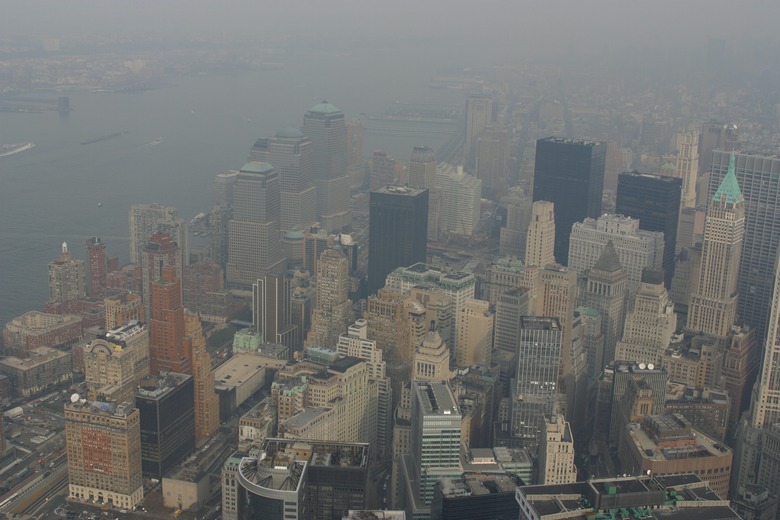Difference Between Industrial Smog & Photochemical Smog
Both industrial and photochemical smog are types of air pollution. There has been an general decrease in air quality since the beginning of the Industrial Revolution, which saw an increase burning of fossil fuels to provide energy. Both types of smog are formed as a result of smoke released from industrial processes. However, there are differences between the two types.
Industrial Smog
Smog occurs as a result of smoke particles from industrial plumes mixing with fog. This mixture produces a yellow-brown color near ground level, as explained by the U.S. Environmental Protection Agency. Industrial smog forms when smoke and sulfur emissions, from coal burning, combine with fog, under the right conditions. While the release of large quantities of air pollutants can form industrial smog, other factors have an important role in the severity of a smog outbreak. A temperature inversion created during the day can trap air pollutants near the surface of the Earth, exacerbating the production of smog, as demonstrated on the University of California at Berkeley website.
Photochemical Smog
In modern times the use of other fossil fuels, nuclear power and renewable energy has led to a reduction in the use of coal and therefore reduced the levels of industrial smog, according to David W. Brooks at the University of Nebraska-Lincoln. However, the combustion of other fossil fuels, such as gasoline by motor vehicles and industry, releases primary pollutants: volatile organic compounds and nitrogen oxides, which lead to the production of photochemical smog.
Best Conditions for Smog Formation
Smog is generally a problem in major cities, where many cars lining the streets release the primary pollutants that produce photochemical smog. In addition, the hub of industry within and surrounding major cities, contributes towards the development of both types of smog. London was known for having problems with industrial smog during the early 1950s, whereas cities such as Los Angeles and New York frequently suffer episodes of photochemical smog, according to David W. Brooks at the University of Nebraska-Lincoln. In addition, communities located in valleys, with less air circulation, can see a greater accumulation of air pollutants than open areas.
Effects of Smog
During the summer months, the formation of photochemical smog is greatest due to increased sunlight exposure. Ground-level ozone, the main component of photochemical smog, is harmful to living organisms because it reacts with and alters, or destroys, other molecules, according to the EPA. Moreover, excessive ozone exposure can reduce crop yields and forest growth. In humans, exposure to industrial and/or photochemical smog can lead to respiratory problems.
Cite This Article
MLA
Newton, John. "Difference Between Industrial Smog & Photochemical Smog" sciencing.com, https://www.sciencing.com/difference-between-industrial-smog-photochemical-smog-10005526/. 24 April 2017.
APA
Newton, John. (2017, April 24). Difference Between Industrial Smog & Photochemical Smog. sciencing.com. Retrieved from https://www.sciencing.com/difference-between-industrial-smog-photochemical-smog-10005526/
Chicago
Newton, John. Difference Between Industrial Smog & Photochemical Smog last modified March 24, 2022. https://www.sciencing.com/difference-between-industrial-smog-photochemical-smog-10005526/
